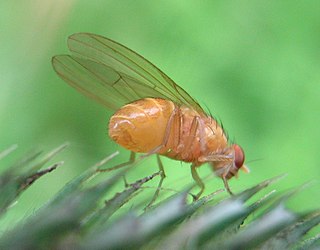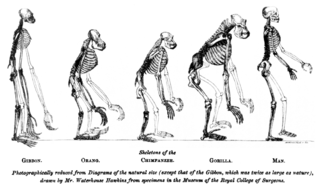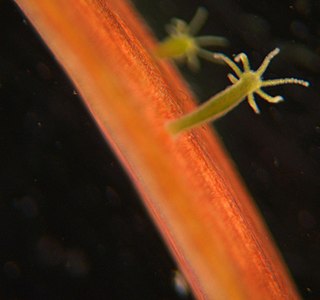
Biology – The natural science that involves the study of life and living organisms, including their structure, function, growth, origin, evolution, distribution, and taxonomy.

A clade, also known as monophyletic group, is a group of organisms that consists of a common ancestor and all its lineal descendants, and represents a single "branch" on the "tree of life".

Macroevolution is evolution on a scale at or above the level of species, in contrast with microevolution, which refers to smaller evolutionary changes of allele frequencies within a species or population. Macroevolution and microevolution describe fundamentally identical processes on different time scales.
Zoology is the branch of biology that studies the animal kingdom, including the structure, embryology, evolution, classification, habits, and distribution of all animals, both living and extinct, and how they interact with their ecosystems. The term is derived from Ancient Greek ζῷον, zōion, i.e. "animal" and λόγος, logos, i.e. "knowledge, study".

Standard anatomical terms of location deal unambiguously with the anatomy of animals, including humans.

Robert Edmond Grant MD FRCPEd FRS FRSE FZS FGS was a Scottish anatomist and zoologist.
In a vascular plant, the stele is the central part of the root or stem containing the tissues derived from the procambium. These include vascular tissue, in some cases ground tissue (pith) and a pericycle, which, if present, defines the outermost boundary of the stele. Outside the stele lies the endodermis, which is the innermost cell layer of the cortex.

Symmetry in biology is the balanced distribution of duplicate body parts or shapes within the body of an organism. In nature and biology, symmetry is always approximate. For example, plant leaves – while considered symmetrical – rarely match up exactly when folded in half. Symmetry creates a class of patterns in nature, where the near-repetition of the pattern element is by reflection or rotation.

In alpha taxonomy, a grade is a taxon united by a level of morphological or physiological complexity. The term was coined by British biologist Julian Huxley, to contrast with clade, a strictly phylogenetic unit.

Plant anatomy or phytotomy is the general term for the study of the internal structure of plants. Originally it included plant morphology, the description of the physical form and external structure of plants, but since the mid-20th century plant anatomy has been considered a separate field referring only to internal plant structure. Plant anatomy is now frequently investigated at the cellular level, and often involves the sectioning of tissues and microscopy.

Plant morphology or phytomorphology is the study of the physical form and external structure of plants. This is usually considered distinct from plant anatomy, which is the study of the internal structure of plants, especially at the microscopic level. Plant morphology is useful in the visual identification of plants.
Biology is the natural science that studies life and living organisms, including their physical structure, chemical processes, molecular interactions, physiological mechanisms, development and evolution. Despite the complexity of the science, there are certain unifying concepts that consolidate it into a single, coherent field. Biology recognizes the cell as the basic unit of life, genes as the basic unit of heredity, and evolution as the engine that propels the creation and extinction of species. Living organisms are open systems that survive by transforming energy and decreasing their local entropy to maintain a stable and vital condition defined as homeostasis.

Evolutionary physiology is the study of physiological evolution, which is to say, the manner in which the functional characteristics of individuals in a population of organisms have responded to selection across multiple generations during the history of the population.

A branch collar is the often visible swelling in a woody plant that forms at the base of a branch where it is attached to its parent branch or to the tree's trunk. The top of the branch collar consists of dense interlocking wood grain, which provides mechanical support to the branch attachment. Branch collars can also be flat or somewhat recessed into the trunk or parent branch, as in some conifers. The collar consists primarily of tissues connected directly to the tree's main trunk or stem, not to the branch.
The evolution of biological complexity is one important outcome of the process of evolution. Evolution has produced some remarkably complex organisms - although the actual level of complexity is very hard to define or measure accurately in biology, with properties such as gene content, the number of cell types or morphology all proposed as possible metrics.
Evolutionary developmental biology (evo-devo) is the study of developmental programs and patterns from an evolutionary perspective. It seeks to understand the various influences shaping the form and nature of life on the planet. Evo-devo arose as a separate branch of science rather recently. An early sign of this occurred in 1999.

Evolution is the process of change in all forms of life over generations, and evolutionary biology is the study of how evolution occurs. Biological populations evolve through genetic changes that correspond to changes in the organisms' observable traits. Genetic changes include mutations, which are caused by damage or replication errors in organisms' DNA. As the genetic variation of a population drifts randomly over generations, natural selection gradually leads traits to become more or less common based on the relative reproductive success of organisms with those traits.

Sessility is the biological property of an organism describing its lack of a means of self-locomotion. Absent natural motility sessile organisms are normally immobile. This is distinct from the botanical meaning of sessility, which refers to an organism or biological structure attached directly by its base without a stalk.
Behavioral plasticity refers to a change in an organism's behavior that results from exposure to stimuli, such as changing environmental conditions. Behavior can change more rapidly in response to changes in internal or external stimuli than is the case for most morphological traits and many physiological traits. As a result, when organisms are confronted by new conditions, behavioral changes often occur in advance of physiological or morphological changes. For instance, larval amphibians changed their antipredator behavior within an hour after a change in cues from predators, but morphological changes in body and tail shape in response to the same cues required a week to complete.














